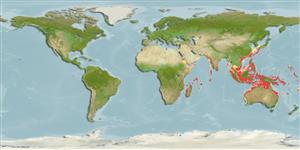>
Eupercaria/misc (Various families in series Eupercaria) >
Labridae (Wrasses)
Etymology: Leptojulis: Greek, leptos = thin + Greek, ioulis, a fish dealing with genera Coris or Thalassoma (Ref. 45335).
More on author: Bleeker.
Environment: milieu / climate zone / depth range / distribution range
Ecologia
marino associati a barriera corallina; distribuzione batimetrica 4 - 75 m (Ref. 90102). Tropical
Indo-West Pacific: Gulf of Oman to the Philippines and Australia.
Size / Peso / Age
Maturity: Lm ? range ? - ? cm
Max length : 13.0 cm TL maschio/sesso non determinato; (Ref. 2334)
Spine dorsali (totale) : 9; Raggi dorsali molli (totale) : 11; Spine anali: 3; Raggi anali molli: 11 - 12. Slender species, usually with brown or dusky mid-lateral stripe. Male with reflective blue spot in the dark band, just past pectoral fin (Ref. 48636).
Found in clear coastal slopes to outer reef lagoons on open rubble patches or rocky bottom (Ref. 48636). Occurs in groups (mostly females) on or near reefs, usually where the water is somewhat turbid and rich in plankton. Fish in the initial phase are much more abundant than the terminal males. Feeds on zooplankton at least a meter above the substrate.
Life cycle and mating behavior
Maturità | Riproduzione | Deposizione | Uova | Fecundity | Larve
Oviparous, distinct pairing during breeding (Ref. 205).
Randall, J.E., 1996. Second revision of the labrid fish genus Leptojulis, with descriptions of two new species. Indo-Pac. Fish. (24):20 p. (Ref. 12420)
IUCN Red List Status (Ref. 130435: Version 2024-1)
Threat to humans
Harmless
Human uses
Pesca: scarso interesse commerciale; Acquario: Commerciale
Strumenti
Special reports
Download XML
Fonti Internet
Estimates based on models
Preferred temperature (Ref.
123201): 24.3 - 29, mean 28 °C (based on 1360 cells).
Phylogenetic diversity index (Ref.
82804): PD
50 = 0.5312 [Uniqueness, from 0.5 = low to 2.0 = high].
Bayesian length-weight: a=0.00977 (0.00470 - 0.02030), b=3.07 (2.90 - 3.24), in cm total length, based on LWR estimates for this (Sub)family-body shape (Ref.
93245).
Trophic level (Ref.
69278): 3.4 ±0.45 se; based on food items.
Resilienza (Ref.
120179): Alto, tempo minimo di raddoppiamento della popolazione meno di 15 mesi (Preliminary K or Fecundity.).
Fishing Vulnerability (Ref.
59153): Low vulnerability (10 of 100).
Nutrients (Ref.
124155): Calcium = 94.5 [55.1, 175.1] mg/100g; Iron = 0.878 [0.502, 1.658] mg/100g; Protein = 18.2 [15.3, 20.4] %; Omega3 = 0.172 [0.102, 0.286] g/100g; Selenium = 27.1 [15.1, 52.2] μg/100g; VitaminA = 222 [67, 805] μg/100g; Zinc = 1.66 [1.11, 2.61] mg/100g (wet weight);
